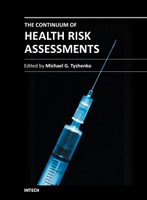Chapter 3 Xenotropic Murine Leukemia Virus-Related Virus as a Case Study: Using a Precautionary Risk Management Approach for Emerging Blood-Borne Pathogens in Canada
Author(s)
Oraby, Tamer
Aspinall, Willy
Wu, Jun
ElSaadany, Susie
Tyshenko, Michael G.
Ganz, Peter R.
Laderoute, Marian
Krewski, Daniel
Collection
European Research Council (ERC); EU collectionLanguage
EnglishAbstract
In October 2009 it was reported that 68 of 101 patients with chronic fatigue syndrome (CFS) in the United States, when tested, were infected with a novel gamma retrovirus, xenotropic
murine leukemia virus-related virus (XMRV) (Lombardi et al., 2009). XMRV is a recently
discovered human gammaretrovirus first described in prostate cancers that shares
significant homology with murine leukemia virus (MLV) (Ursiman et al., 2006). It is known
that XMRV can cause leukemias and sarcomas in several rodent, feline, and primate species
but has not been shown to cause disease in humans. XMRV was detectable in the peripheral
blood mononuclear cells (PBMCs) and plasma of individuals diagnosed with CFS
(Lombardi et al., 2009). After this report was published there was a great deal of uncertainty
surrounding this emergent virus and its involvement in the etiology of CFS. The uncertainty
was, in part, due to CFS being a complex, poorly understood multi-system disorder with
different disease criteria used for its diagnosis. CFS, also known as Myalgic
Encephalomyelitis (ME), is a debilitating disease of unknown origin that is estimated to
affect 17 million people worldwide. The initial report connecting XMRV to prostate cancers
and CFS garnered significant media and scientific interest since it provided a potential
Susie ElSaadany2**, Tamer Oraby1
*
Daniel Krewski1, 4 and Peter R. Ganz5
1McLaughlin Centre for Population Health Risk Assessment, Institute of Population Health, University of
Ottawa, Ontario, Canada
2Blood Safety Surveillance and Health Care Acquired Infections Division, Centre for Communicable Diseases and
Infection Control, Public Health Agency of Canada, Ottawa, Ontario, Canada
3Aspinall and Associates, Cleveland House, High Street, and Earth Sciences, Bristol University, Bristol, United
Kingdom
4Department of Epidemiology and Community Medicine, Faculty of Medicine, University of Ottawa, Ottawa,
Ontario, Canada
5Health Canada, Director’s Office, Ottawa, Ontario, Canada
** Corresponding Author
, Marian Laderoute2
, Jun Wu2
, Willy Aspinall3
,
www.intechopen.com
32 The Continuum of Health Risk Assessments
explanation for the disease but also an avenue for possible therapeutic treatments since
XMRV is known to be susceptible to some anti-retroviral drugs (Cohen, 2011).
Keywords
case study; virus; case study; virus; Blood plasma; Blood-borne disease; Canada; Chronic fatigue syndrome; Polymerase chain reaction; Prostate cancer; Xenotropic murine leukemia virus-related virusDOI
10.5772/38572OCN
1030819683Publisher
InTechOpenPublisher website
https://www.intechopen.com/Publication date and place
2012Grantor
Classification
Science: general issues


 Download
Download